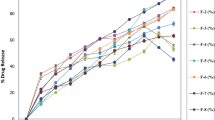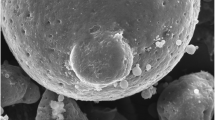Abstract
Purpose
In the present study, a uniform ultra-small microsphere/sucrose acetate isobutyrate (SAIB) hybrid depot (m-SAIB depot) was designed to provide a long-term sustained release drug delivery system which not only reduced the burst release of an SAIB depot, but also eliminated the lag-time of PLGA microspheres.
Methods
Risperidone loaded m-SAIB depot (Ris-m-SAIB depot) was characterized by in vitro drug release, pharmacokinetics, in vivo degradation and biocompatibility, in comparison with risperidone loaded SAIB depot (Ris-SAIB depot).
Results
Ris-m-SAIB depot showed a low burst release (0.64%) and a reduced in vitro drug release rate due to the encapsulation of most drug in microspheres. After intramuscular administration, the in vivo burst release of Ris-m-SAIB was significantly decreased, as reflected by the low Cmax/Cs(4-td) (approximately 30-fold reduction), in comparison with Ris-SAIB depot. From 4 to 78 days, Ris-m-SAIB depot showed a higher plasma drug level (1.55 ~ 16.30 ng/ml) with a steadier drug release profile compared with Ris-SAIB depot. Ris-m-SAIB depot degraded gradually with a degradation t1/2 of 54.6 days and exhibited good biocompatibility in vivo.
Conclusion
These results demonstrate the potential application of a uniform ultra-small microsphere/SAIB hybrid depot for continuously delivering small drug molecules for long periods of time without burst release.










Similar content being viewed by others
Abbreviations
- 9-OH-Ris:
-
9-Hydroxyrisperidone
- AUC:
-
Area under the curve
- BA:
-
Benzyl alcohol
- Cmax :
-
Maximum concentration
- Cmin :
-
Minimum concentration
- Cs :
-
Mean value of plasma concentration at steady-state
- DAS:
-
Drug and statistics software
- DCM:
-
Dichloromethane
- EtOH:
-
Ethanol
- HPLC:
-
High performance liquid chromatography
- Mg(OH)2 :
-
Magnesium hydroxide
- PBS:
-
Phosphate buffered saline
- PLA:
-
Poly-lactide
- PLGA:
-
Poly (lactide-coglycolide)
- PVA:
-
Poly (vinyl alcohol)
- Ris:
-
Risperidone
- Ris-m-SAIB depot:
-
Risperidone loaded microsphere/SAIB hybrid depot
- Ris-SAIB depot:
-
Risperidone loaded SAIB depot
- SAIB:
-
Sucrose acetate isobutyrate
- SEM:
-
Scanning electron microscopy
- SPG:
-
membrane Shirasu porous glass membrane
- t1/2 :
-
Half-life
- UPLC–MS/MS:
-
Ultra performance liquid chromatography-tandem mass spectrometry
References
Uhrich KE, Cannizzaro SM, Langer RS, Shakesheff KM. Polymeric systems for controlled drug release. Chem Rev. 1999;99(11):3181–98.
Heres S, Lambert M, Vauth R. Treatment of early episode in patients with schizophrenia: the role of long acting antipsychotics. Eur Psychiatry. 2014;29 Suppl 2(14):1409–13.
Hoybye C, Christiansen JS. Growth hormone replacement in adults—current standards and new perspectives. Best Pract Res Clin Endocrinol Metab. 2015;29(1):115–23.
Jiang Y, Wang F, Xu H, Liu H, Meng Q, Liu W. Development of andrographolide loaded PLGA microspheres: optimization, characterization and in vitro-in vivo correlation. Int J Pharm. 2014;475(1–2):475–84.
Doan TV, Couet W, Olivier JC. Formulation and in vitro characterization of inhalable rifampicin-loaded PLGA microspheres for sustained lung delivery. Int J Pharm. 2011;414(1–2):112–7.
Hu Z, Liu Y, Yuan W, Wu F, Su J, Jin T. Effect of bases with different solubility on the release behavior of risperidone loaded PLGA microspheres. Colloids Surf B: Biointerfaces. 2011;86(1):206–11.
Shive MS, Anderson JM. Biodegradation and biocompatibility of PLA and PLGA microspheres. Adv Drug Deliv Rev. 1997;28(1):5–24.
Schwendeman SP, Shah RB, Bailey BA, Schwendeman AS. Injectable controlled release depots for large molecules. J Control Release. 2014;190:240–53.
Wischke C, Schwendeman SP. Principles of encapsulating hydrophobic drugs in PLA/PLGA microparticles. Int J Pharm. 2008;364(2):298–327.
Wang J, Wang BA, Schwendeman SP. Characterization of the initial burst release of a model peptide from poly(D, L-lactide-co-glycolide) microspheres. J Control Release. 2002;82(2–3):289–307.
Yang J, Wilson M, Celniker A. Recombinant human growth hormone poly(lactic-co-glycolic acid) (PLGA) microspheres provide a long lasting effect. J Control Release. 1997;49(97):193–205(13).
Ereshefsky L, Mannaert E. Pharmacokinetic profile and clinical efficacy of long-acting risperidone: potential benefits of combining an atypical antipsychotic and a new delivery system. Drugs R&D. 2005;6(3):129–37.
Eerdekens M, Van Hove I, Remmerie B, Mannaert E. Pharmacokinetics and tolerability of long-acting risperidone in schizophrenia. Schizophr Res. 2004;70(1):91–100.
Sun F, Sui C, Teng L, Liu X, Teng L, Meng Q, et al. Studies on the preparation, characterization and pharmacological evaluation of tolterodine PLGA microspheres. Int J Pharm. 2010;397(1–2):44–9.
Luan X, Bodmeier R. Modification of the tri-phasic drug release pattern of leuprolide acetate-loaded poly(lactide-co-glycolide) microparticles. Eur J Pharm Biopharm. 2006;63(2):205–14.
Su Z, Sun F, Shi Y, Jiang C, Meng Q, Teng L, et al. Effects of formulation parameters on encapsulation efficiency and release behavior of risperidone poly(D, L-lactide-co-glycolide) microsphere. Chem Pharm Bull (Tokyo). 2009;57(11):1251–6.
Husmann M, Schenderlein S, Luck M, Lindner H, Kleinebudde P. Polymer erosion in PLGA microparticles produced by phase separation method. Int J Pharm. 2002;242(1–2):277–80.
Berkland C, King M, Cox A, Kim K, Pack DW. Precise control of PLG microsphere size provides enhanced control of drug release rate. J Control Release. 2002;82(1):137–47.
Berkland C, Kim K, Pack DW. PLG microsphere size controls drug release rate through several competing factors. Pharm Res. 2003;20(7):1055–62.
Gao Z, Ding P, Zhang L, Shi J, Yuan S, Wei J, et al. Study of a pingyangmycin delivery system: Zein/Zein-SAIB in situ gels. Int J Pharm. 2007;328(1):57–64.
Kraeling RR, Barb CR, Rampacek GB, Thompson Jr DL, Gibson JW, Sullivan SA, et al. Luteinizing hormone response to controlled-release deslorelin in estradiol benzoate primed ovariectomized gilts. Theriogenology. 2000;53(9):1681–9.
Shi X, Lin X, Yao C, Shen L, Feng Y. Injectable long-acting in situ forming systems for Radix Ophiopogonis polysaccharide. Int J Biol Macromol. 2015;72:553–9.
Okumu FW, Dao LN, Fielder PJ, Dybdal N, Brooks D, Sane S, et al. Sustained delivery of human growth hormone from a novel gel system: SABER. Biomaterials. 2002;23(22):4353–8.
Pechenov S, Shenoy B, Yang MX, Basu SK, Margolin AL. Injectable controlled release formulations incorporating protein crystals. J Control Release : Off J Control Release Soc. 2004;96(1):149–58.
Lin X, Yang S, Gou J, Zhao M, Zhang Y, Qi N, et al. A novel risperidone-loaded SAIB-PLGA mixture matrix depot with a reduced burst release: effects of solvents and PLGA on drug release behaviors in vitro/in vivo. J Mater Sci Mater Med. 2012;23(2):443–55.
Lu Y, Tang X, Cui Y, Zhang Y, Qin F, Lu X. In vivo evaluation of risperidone-SAIB in situ system as a sustained release delivery system in rats. Eur J Pharm Biopharm. 2008;68(2):422–9.
Huang X, Brazel CS. On the importance and mechanisms of burst release in matrix-controlled drug delivery systems. J Control Release. 2001;73(2–3):121–36.
Lu YX, Yu YL, Tang X. Sucrose acetate isobutyrate as an in situ forming system for sustained risperidone release. J Pharm Sci. 2007;96(12):3252–62.
Hogan M. DURECT Receives Complete Response Letter from FDA for POSIDUR™ (SABER®-Bupivacaine). 2014 February 12. Available from: http://phx.corporate-ir.net/phoenix.zhtml?c=121590&p=irol-newsArticle&ID=1899590.
Qi F, Wu J, Yang T, Ma G, Su Z. Mechanistic studies for monodisperse exenatide-loaded PLGA microspheres prepared by different methods based on SPG membrane emulsification. Acta Biomater. 2014;10(10):4247–56.
Qi F, Wu J, Fan QZ, He F, Tian GF, Yang TY, et al. Preparation of uniform-sized exenatide-loaded PLGA microspheres as long-effective release system with high encapsulation efficiency and bio-stability. Colloids Surf B: Biointerfaces. 2013;112(3):492–8.
Piacentini E, Drioli E, Giorno L. Membrane emulsification technology: twenty-five years of inventions and research through patent survey. J Membr Sci. 2014;468(20):410–22.
Thomas C, Gupta V, Ahsan F. Particle size influences the immune response produced by hepatitis B vaccine formulated in inhalable particles. Pharm Res. 2010;27(5):905–19.
Tran VT, Benoit JP, Venier-Julienne MC. Why and how to prepare biodegradable, monodispersed, polymeric microparticles in the field of pharmacy? Int J Pharm. 2011;407(1–2):1–11.
Procter BG, Chappel CI. Subchronic toxicity studies of sucrose acetate isobutyrate (SAIB) in the rat and dog. Food Chem Toxicol. 1998;36(2):101–10.
Reynolds RC. Metabolism and pharmacokinetics of sucrose acetate isobutyrate (SAIB) and sucrose octaisobutyrate (SOIB) in rats, dogs, monkeys or humans: a review. Food Chem Toxicol. 1998;36(2):95–9.
Reynolds RC, Chappel CI. Sucrose acetate isobutyrate (SAIB): historical aspects of its use in beverages and a review of toxicity studies prior to 1988. Food Chem Toxicol. 1998;36(2):81–93.
Phillips JC, Kingsnorth J, Rowland I, Gangolli SD, Lloyd AG. Studies on the metabolism of sucrose acetate isobutyrate in the rat and in man. Food Cosmet Toxicol. 1976;14(5):375–80.
Gogolewski S, Jovanovic M, Perren SM, Dillon JG, Hughes MK. Tissue response and in vivo degradation of selected polyhydroxyacids: polylactides (PLA), poly(3-hydroxybutyrate) (PHB), and poly(3-hydroxybutyrate-co-3-hydroxyvalerate) (PHB/VA). J Biomed Mater Res. 1993;27(9):1135–48.
Huffman K, Casey D. Effect of carboxyl end groups on hydrolysis of polyglycolic acid. J Polym Sci Polym Chem Ed. 1985;23(7):1939–54.
Kazazi-Hyseni F, Zandstra J, Popa ER, Goldschmeding R, Lathuile AA, Veldhuis GJ, et al. Biocompatibility of poly(d, l-lactic-co-hydroxymethyl glycolic acid) microspheres after subcutaneous and subcapsular renal injection. Int J Pharm. 2015;482(1–2):99–109.
Pajander J, Soikkeli AM, Korhonen O, Forbes RT, Ketolainen J. Drug release phenomena within a hydrophobic starch acetate matrix: FTIR mapping of tablets after in vitro dissolution testing. J Pharm Sci. 2008;97(8):3367–78.
ACKNOWLEDGMENTS AND DISCLOSURES
Dr. David B Jack is gratefully thanked for correcting English of the manuscript.
Author information
Authors and Affiliations
Corresponding authors
Rights and permissions
About this article
Cite this article
Lin, X., Xu, Y., Tang, X. et al. A Uniform Ultra-Small Microsphere/SAIB Hybrid Depot with Low Burst Release for Long-Term Continuous Drug Release. Pharm Res 32, 3708–3721 (2015). https://doi.org/10.1007/s11095-015-1731-1
Received:
Accepted:
Published:
Issue Date:
DOI: https://doi.org/10.1007/s11095-015-1731-1




